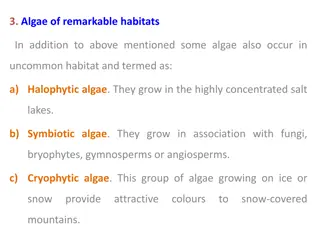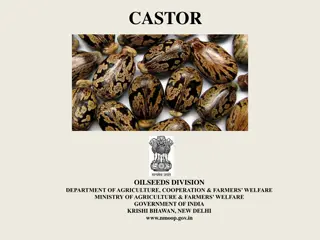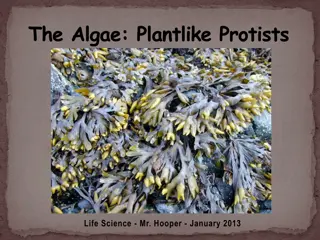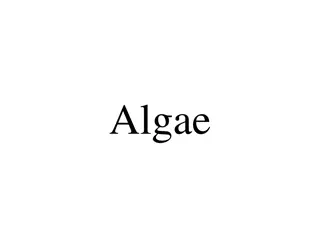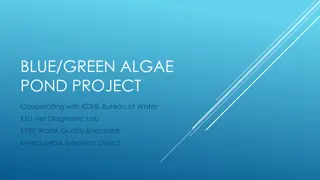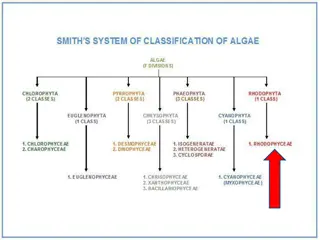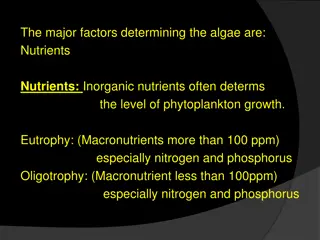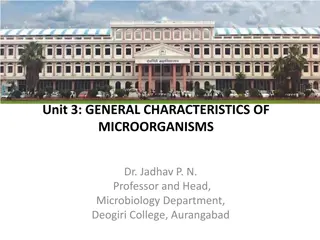Understanding Blue-Green Algae: Cultivation, Nutrient Composition, and Properties
Blue-green algae, also known as cyanobacteria, are photosynthetic bacteria that thrive in warm, nutrient-rich water bodies. They are packed with essential nutrients like vitamins, minerals, and amino acids, making them a valuable resource for overall health. Learn about the cultivation, uses, and historical significance of blue-green algae in this informative guide.
Download Presentation

Please find below an Image/Link to download the presentation.
The content on the website is provided AS IS for your information and personal use only. It may not be sold, licensed, or shared on other websites without obtaining consent from the author. Download presentation by click this link. If you encounter any issues during the download, it is possible that the publisher has removed the file from their server.
E N D
Presentation Transcript
Sengamala Thayaar Educational Trust Womens College (Affiliated to Bharathidasan University) (Accredited with A Grade {3.45/4.00} By NAAC) (An ISO 9001: 2015 Certified Institution) Sundarakkottai, Mannargudi-614 016. Thiruvarur (Dt.), Tamil Nadu, India. MEC III-BASIC BIOTECHNOLOGY-16SMBEBC3 Dr. R. ANURADHA ASSISTANT PROFESSOR & HEAD PG & RESEARCH DEPARTMENT OF BIOCHEMISTRY
C UL T IVAT IO NANDUS E SO F B IO F E R T IL IZ E R S
CULTIVATION AND USES OF BIOFERTILIZERS INTRODUCTION :- Blue green algae, also known as cyanobacteria,are a group of photosynthestic bacteria that many people refer to as "pond scum". Blue green algae are most often blue-green algae in colour, but can also be blue, green, reddish- purple,or blue. Blue green algae generally grow in lakes, ponds, and slow- moving streams when the water is warm and enrich with nutrients like phosphorus or nitrogen. When environmental conditions are just right, blue green algae can grow very quickly in number.
Most species are buoyant and will float to the surface, where they form scum layer or floating mats. When this happens, We call this a " blue green algae bloom". NUTRIENT COMPOSITION :- Blue green algae are widely considered to be a whole food for the skin and body. It contains a broad spectrum of nutrients, including essential fatty acids, vitamins,minerals, protein, amino acids, and enzymes. BLUE GREEN ALGAE CONTAINS Vitamin A( beta- carotene), Vitamin C(ascorbic acid), Choline,
Folic acid, Thiamine (vitamin B1), Riboflavin (vitamin B2), Niacin (vitamin B3), Pantothenic acid (vitamin B5), Pyridoxine ( vitamin B6), Cobalamin (vitamin B12), Biotin, Vitamin E, and Vitamin K.
It also contains several essential track minerals, including calcium, chloride, chromium, copper, iron, magnesium, manganese, phosphorus, potassium, and sodium, and zinc. Blue-green algae are one of the very few botanical sources of all twenty essential amino acid. PROPERTIES OF BLUE GREEN ALGAE:- A simple organism, blue green algae lacks the distinct organs like leaves and root of land plants and has some characteristics of bacteria. They are a rich source of probiotics, useful to replace good bacteria lost through the use of antibiotics in humans. The structure of chlorophyll is very similar to that of hemoglobin, making the nutrients in blue green algae easily assimilate by humans.
HISTORY OF BLUE GREEN ALGAE : HISTORY OF BLUE GREEN ALGAE :- - Blue green algae was used by the ancient Egyptians as Blue green algae was used by the ancient Egyptians as colourful colourful eye shadow. The largest and most complex eye shadow. The largest and most complex froms algae, seaweeds are an important source of food in many algae, seaweeds are an important source of food in many countries. Also, called vegetable plankton, blue green algae countries. Also, called vegetable plankton, blue green algae grow throughout the world. grow throughout the world. froms of of CULTURE (SPIRULINA) :- SYSTEMATIC POSITION Spirulina is a blue green algae belonging to CLASS ORDER : NOSTOCALES FAMILY : OSCILLATORIACEAE : CYANOBACTERIA
The research work in lndia with regard to utilization has largely been carried out with 2 species. (1) Spirulina platensis (2) Fusiformis
CULTURE OF BLUE GREEN ALGAE :- (1) The commercial design of Spirulina culture system comprises a network of coment raceways with paddle- wheel agitation to prevent algal accumulation at the surface & to ensure uniform distribution of nutrients, with modification in terms of vertical reactors, tubular reactors etc... (2) The outdoor culture parameters are cement raceways or vats preferably with a mid- rip for facilitating water circulation. (3) Culture medium depth15-20cm agitation 20cm/sec. (4) pH 9-11 provided with nutrients. zarrouk's medium is used in indoor. (5) light intensity20-30k lux, hardness 120mg/l.
(6) The culture volume of gradually upgrade to the level of outdoor cisterms where mass culture medium may be used. (7) Provision of half of the quantity of sodium bicarbonate (9g/l) or carbon-dioxide bubbling is suggested. (8) Several low cost inputs like blogases slurry have been tried with measurable success, which may be incorporated. (9) A continuous culture method of harvesting & nutrient dosing is paracticed & the vats are cleaned after 4-6 months. (10) Contamination is minimal due to highly alkaline pH level. (11) The wet biomass is sun dried on polythene sheets by the visual or spray- dried in mechanised unit
Unit for marketing purposes. The culture of Spirulina needs to be carried out with almost care with spray- drying the product is for human consumption. NATURAL PRODUCTION :- Most commercial protection systems are based on shallow raceways in which spirulina culture are mixed by a paddle wheel. However, there are still some examples of Spirulina being harvested commercially from natural occuring population.
GROWTH OF BLUE GREEN ALGAE :- (1) day to grow and thrive. (2) pond , that it contains phosphorus, nitrogen and other particles necessary for it to grow. (3) Use pond skimmer to remove any algae that floats to the top of the container. It requires at least six hours of sunlight a Fill the container with water from a HARVESTING AND PROCESSING. :- Spirulina harvesting, processing and packing has eight principal stage : (1) FILTRATION AND CLEANING :- A nylon filter at the entrance of the water pond is needed.
(2) PRE-CONCENTRATION :- To obtain algae biomass which is washed reduce salts content. (3) CONCENTRATION :- To remove the highest possible amount of interstitial water ( located among the filaments). (4) NEUTRALIZATION :- To neutralize the biomass with the addition of acid solution. (5) DISINTEGRATION. :- To break down trichomes by a grinder, (6) DEHYDRATION BY SPRAY- DRYING :- This operation has great economic importance since it involves about 20-30 percent of the production cost.
(7) PACKING :- It is usually in sealed plastic bags to avoid hygroscopic action on the dry spirulina. (8) STORAGE :- Stored in fresh,dry,unlit,pest- free,and hygienic storerooms to prevent spirulina pigments from deteriorating. APPLICATION OF BLUE GREEN ALGAE :- (1) It is a healthy food & nutritional supplement for the human being has unlimited scope in the future. (2) It has been shown to be a therapeutic with regard to several disseses like night blinders, anaemia, glucomia, cholesterol accumulation, pancreatis etc.....
(3) Its antioxidant properties have been attributed with cancer prevention possibilities. (4) Studies showed higher fish growth rates with spirulina. (5) Pigmentation of omamental fishes & prawn larvae has commercial significance. (6) New area of Spirulina application are with regard to extraction of valuable enzymes like phosphoglycerokinase specific for ATP determination, superoxide dismutase required genetic engineering & phycobillin used in immunodiagnostics. (7) The effect of Spirulina on the nourishment of skin have paved the way for cosmetic formulations using this alga.
(8) spirulina with regard to human/animal nutrition & therapy command a high export value as also import substitution. CONCLUSION :- Spirulina culture,in fact is being used as a reduce pollution from wastewater like domestic sewage.Achieving the twin objectives of pollution reduction & nutrient in the from of a high quality protein. This is also serves for certain phenmaceutical product involving extraction procedures. Spirulina is a natural gift among the aqua product, whose potential can be hamesed for better nutrition, health economics & environment.



